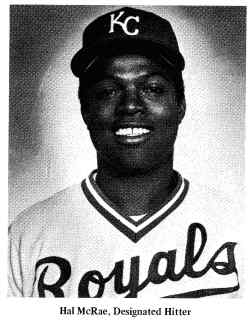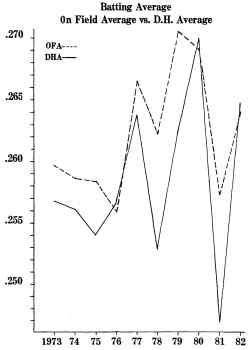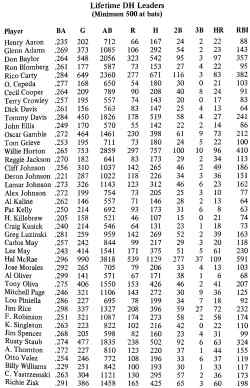
| Ten Years of the Designated Hitter |
 |
 |
|
By Harry Agens Hal McRae of the Kansas City Royals climaxed his 10-year efforts as a Designated Hitter in 1982 with the best season achieved thus far under this system. He hit for a .310 average and set several season records including most runs scored, 9 1, most hits, 189, most doubles, 46, most total bases, 332, and most runs batted in, 133. The latter figure led the American League, marking the first time a DH led an important total number category. In 1977 Jim Rice led in slugging percentage, but he was not the DH for the full season. With his great season, McRae also moved comfortably out in front in most DH career categories. He has played 990 games and has gone to bat 3818 times. His chief career contenders – Willie Horton and Rico Carty - are far back and, furthermore, are no longer in the majors. Don Baylor seems to be his primary future competition and is closest in home runs with 97 to 109 for McRae. The latter even leads in bases on balls with 350 and stolen bases with 72, which are not closely associated with the DH. Willie Horton leads in strikeouts with 532 and Jim Rice leads in batting average with .298 and slugging average with .546. After ten seasons of the DH, a brief review of its origin and operation would be appropriate. Batting in the 1960s reached a low level of achievement. We are reminded that in 1968 the American League almost finished the season with a batting leader hitting under .300. Fortunately, Carl Yastrzemski was able to pull himself up to .301 by the time the curtain fell. Because of the general deterioration in hitting and the painfully small contribution made by pitchers, the International League in 1969 experimented with a system whereby a team could designate another player to hit for the pitcher. Some managers claimed they disliked the idea but, even though the DH was optional, they all used it. Based on the minor league experiments, discussion then centered on possible adoption of this rule change at the major league level. Commissioner Bowie Kuhn, who for several years had insisted that batting averages ought to be higher, favored adoption of the DH. The National League refused to go along with the idea, but the American League decided at its winter meeting in December 1972 to adopt it on an experimental basis starting with the 1973 season. There was much speculation at the time about whether all clubs would use this opportunity to beef up their attack or would still go with some of their better hitting hurlers. As it turned out, AL managers essentially accepted the DH concept from the first day of the 1973 season when Ron Blomberg of the Yankees made it into the trivia books as the first DH on April 7. With the bases loaded in the first inning, he was walked by pitcher Luis Tiant of the Red Sox. By design or accident, a few pitchers got to hit that season. In 1976, Ken Brett of the White Sox, who was considered the top batter among pitchers, got to bat 12 times, but collected only one hit. In 1978 there was only one at bat by an American League hurler. In the early years, older players in the twilight of their careers, such as Rico Carty, Tommy Davis, Harmon Killebrew and Tony Oliva, were used. Even such first choice Hall of Famers as Henry Aaron and Al Kaline prolonged and closed out their careers as designated hitters. Later the position became more refined with the utilization of players with speed and power such as Hal McRae, Jim Rice and Don Baylor. Some clubs rotated their right- and left- handed batters as the DH. However, in 1978 Rusty Staub played the full schedule of 162 games as DH for the Tigers and the next year Willie Horton duplicated this feat for Seattle. The American League managers seemed to be well satisfied with the DH and after a three-year trial adopted a permanent rule in 1976. At the present time every league in Organized Baseball uses the DH rule except the National League. The DH rule has been used in the World Series since 1976 on alternate years. A review of American League hitting over the past ten years certainly leaves no doubt that run production has been enhanced. This was specifically demonstrated in 1982 when three designated hitters finished the season with more than 100 runs batted in - McRae, Andre Thornton, and Greg Luzinski. However, a closer analysis reveals that the designated hitters still are not at the same level with the other players. We have broken American League hitting statistics into two parts - the on field average (OFA) and the designated hitter average (DHA) and in only two of the ten years was the DHA higher than the OFA. This is shown in the accompanying graph. Our next step was to compare batting averages of players who alternated during the season as DH and in the field. On 118 occasions in the past ten years a player has gone to bat at least 100 times as a field player and as a DH. In only 37 cases or 31 percent of the time has a player's DHA been higher than his OFA. We then did the same thing with individual players who played both ways in at least three different seasons. Of the 11 players in that category, only two - Baylor and McRae - hit better as DH. The nine others Cooper, Gamble, Grieve, Reggie Jackson, Lamar Johnson, Piniella, Rice, Yastrzemski, and Zisk - hit better as field performers. Gamble, as an extreme example, hit about 68 points better when playing in the field. Players Who Played in the Field and DH the Same Year (Minimum of 100 AB both ways at least 3 seasons)
Although traditionalists are still against the DH rule, it has had some positive effects. Players whose careers might otherwise have been over are still able to contribute. The hit-and-run play is flow being used more at the bottom of the lineup. To my way of thinking, it still proves to be a better method than having the pitcher try to bat. Not all the results have been positive. It has had an adverse effect on starting pitchers because the easy out has been eliminated. Games prove to be longer now because pitching changes are made more during innings than at the end. Also, the American League seems to be at a disadvantage during the non-DH World Series. Carried below are the top season and career records for designated hitters. On the next page are listed the 42 players who have batted at least 500 times as a designated hitter since the system was started in 1973. Designated Hitter Season Records Games 162- Rusty Staub, Det., 1978; Willie Horton, Seattle, 1979 At Bats 646 - Willie Horton, Seattle, 1979 Runs 91 - Hal McRae, Kansas City, 1982 Hits 189 Hal McRae, Kansas City, 1982 Doubles 46 - Hal McRae, Kansas City, 1982 Triples 13 - Jim Rice, Houston, 1977 Homers 31 - Jim Rice, Boston, 1977; Rico Carty, Tor-Oak., 1978 Total Bases 332 Hal McRae, Kansas City, 1982 RBI 133 Hal McRae, Kansas City, 1982 Bases on Balls 81 Frank Robinson, Cal-Clev., 1974 Strikeouts 114 - Willie Horton, Texas 1977 Stolen Bases 17 - Tommy Harper, Cal-Oak., 1975 Batting Ave. .316 Jim Rice, Boston, 1977 Slugging Ave. .638 - Jim Rice, Boston, 1977 Designated Hitter Career Records Games - Hal McRae 990; Willie Horton 753; Rico Carty 649 At Bats - Hal McRae 3818; Willie Horton 2859; Rico Carty 2360 Runs - Hal McRae 539; Don Baylor 323; Willie Horton 297 Hits - Hal McRae 1129; Willie Horton 757; Rico Carty 671 Doubles - Hal McRae 277; Rico Carty 116; Willie Horton 100 Triples - Hal McRae 37; Jim Rice 27; Willie Horton 10 Homers - Hal McRae 109; Don Baylor 97; Willie Horton 96 Total Bases - Hal McRae 1807; Willie Horton 1165; Rico Carty 1042 RBI - Hal McRae 591; Willie Horton 410; Rico Carty 382 BA (1000 AB) - Jim Rice .298; Hal McRae .296; Richie Zisk .291 SA (1000 AB) - Jim Rice .546; Oscar Gamble .475; Hal McRae .473 |
|||||||||||||||||||||||||||||||||||||||||||||||||||||||||||||||||||||||||||||||||||||||||||||||||||||||||||||||||||||||||||||||||||||||

 Ten Years of Designated Hitters
Ten Years of Designated Hitters

